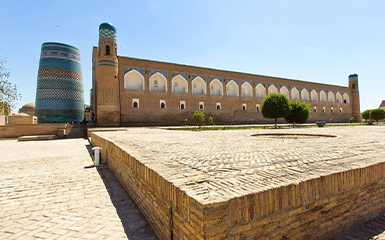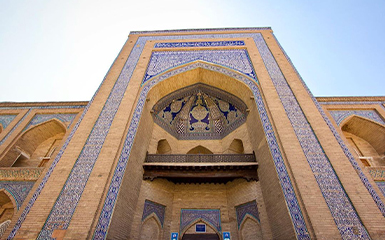Bahauddin complex
Char Minar
Lyab-I Hauz complex
Poi Kalan complex
The Ark Citadel
Bolo Haouz Mosque
Kalan Minaret
Islam Khodja complex
Itchan Kala
Kalta Minaret
Kunya Ark
Kutlugmurat Anak
Alla Kuli Khan
Muhammad Rahim Khan
Muhammed Emin Khan
Pahlawan Mahmud
Tash Hauli
Juma Mosque
Andijan
Muynak
Rabati Malik
Madrasah of Muhammad Rahim Khan II is an architectural monument, a madrasah building in the historical centre of Khiva (Uzbekistan), erected in 1871 at the expense and by order of the Uzbek ruler Muhammad Rahim Khan II. Located opposite the gates of the Kunya-Ark citadel.
The founder of the madrasah, Muhammad Rahim Khan II, was an enlightened ruler. He wrote poetry under the pseudonym Firuz, made a great contribution to the development of education and culture in Khorezm in the late 19th - early 20th centuries. Kamil Khorezmi and other poets dedicated several poetic chronograms to the date of the construction of the madrasah and the palace of this ruler.
As part of Itchan-Kala in 1990, it was included in the list of UNESCO World Heritage Sites. Currently it is the object of tourist service and display.
The main facade of the Muhammad Rahim Khan madrasah is separated from the street by an outer courtyard, surrounded by a blank wall outside and surrounded by one-story domed hujras inside.
Madrasah is one of the largest in Khiva. It has a traditional layout and consists of a courtyard surrounded by hujras on two floors. The entrance openings of a part of the hujras face the site in front of the main facade of the madrasah.
On all four facades of the inner courtyard of the madrasah, there are ceremonially and colourfully decorated portals, partially covered with coloured majolica tiles. It is dominated by white and blue colours. Above the tympanum of all the portals there are dedicatory inscriptions (verses), including grandiloquent phrases that are chronograms. The inscriptions on the main portal (peshtak), above the entrance and on the portals of the courtyard are also part of the decoration of the madrasah. Some of the texts have been lost.
On the right (southern) cheek wall of the entrance niche of the portal, a marble slab is mounted on which a text in the Old Uzbek language is carved with a document on the donation of real estate for the maintenance of a madrasah (waqf-name). It must be said that such a phenomenon (that is, the carving of such a document on a stone and its installation on a building) is rare for Muslim countries. However, on the monuments of Khiva (especially in the second half of the 19th century), it is quite common. Actually, the document describes the boundaries of the donated land located in the district of the city of Khiva.


